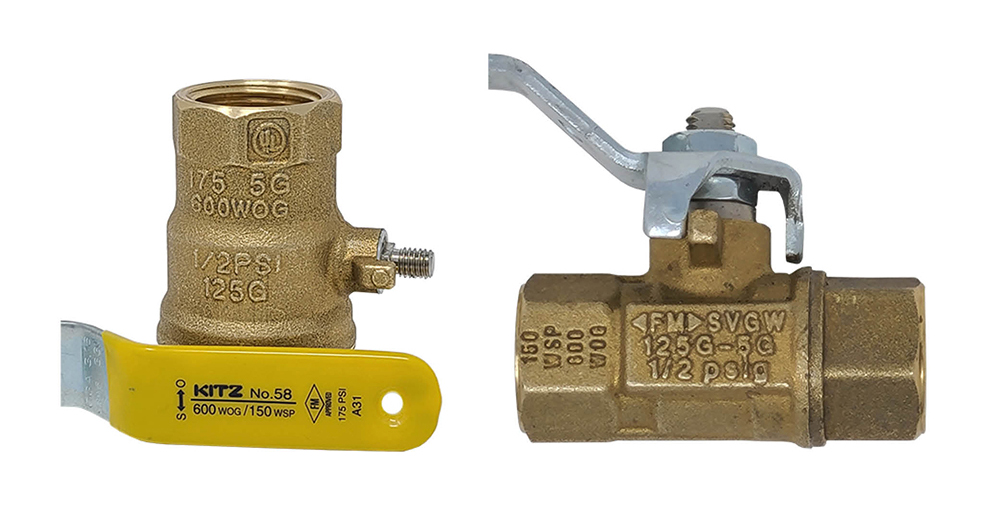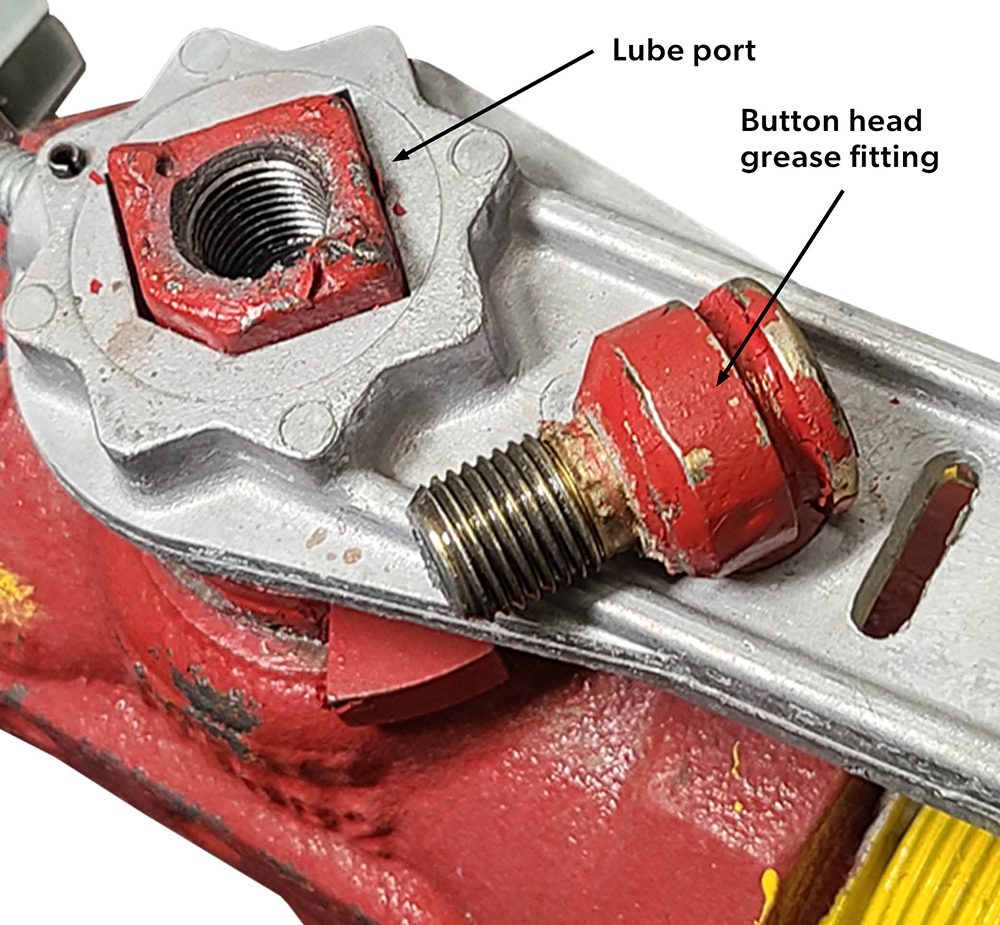Competency B1: Select Regulators, Valves, and Valve Train Components
Learning Task 1
Describe Manual Valves
Manual gas valves are incorporated into the piping system in different ways to provide a method of ensuring that the gas has been positively turned off to an area of the piping system or to a particular appliance. The gas fitter will need to select the correct valve for the job to be done. The gas codes will specify particular locations and applications that require the installations of manual gas valves.
For example, the CSA B149.1 Installation Code clearly requires that a readily accessible gas shut-off valve for each appliance be installed. This manual appliance shut-off valve is typically located just outside of the appliance, where it can be easily reached, to enable the gasfitter to isolate the appliance to perform any necessary repairs or service.
Types of Manual Gas Valves
Most gas shut-off applications will require the use of a manual valve that will fully open or close with a quarter-turn of the handle. Ball valves and lubricated plug valves are the most common, but eccentric types are also used on larger pipelines. Globe, butterfly, and needle types are also used for throttling applications.
Valve ratings
All gas valves must be used within their certified pressure and temperature rating range. The gas installation code recognizes a number of different certification organizations and standards for manual shut-off valves. The markings on the gas valve and or the manufactures specification can be checked to verify the intended purpose for the valve. The multiple approvals that are typically found on each valve can become confusing, as the manufacture attempts to mark all the associated certifications onto the valve body and or handle (Figure 1).

Common pressure class or rating markings that are found on gas valves include:
- WOG stands for Water, Oil and Gas and CWP stands for Cold Working Pressure. They both refer to the non-shock pressure rating for valves at an ambient temperature up to 380 C. Water is straightforward but the oil and gas parts are a little more complicated. “Gas” references air, nitrogen etc. but does not cover combustible gases. There are more specific approvals required for fuel gas applications.
- WSP stands for Working Steam Pressure and defines the pressure of steam in a system that a valve can be used in. The industry uses WSP for bronze ball valves because, as the temperature rises, the strength of the material decreases.
- G is for combustible gases, as not all valves are certified for use on fuel gas applications. Valves that are certified for combustible gas applications will have some or all of the following specific markings:
- ½ PSIG (or ½ G) – a lower pressure rating for gas valves generally used at a gas fired appliance.
- 5G – a higher pressure rating for gas valves generally used indoor and out in Canada on gas piping distribution systems.
- 125G – a USA gas pressure rating of 125 PSIG for use in gas piping systems.
- CAN/CGA-3.16 – a Canadian gas pressure rating of 125 PSIG for outdoor use in gas piping systems
The most common certification organizations abbreviations that appear on valves to identify their rating are:
- UL – Underwriter’s Laboratories tests valves to 3 times the pressure rating stated on the valve body. These valves must pass UL’s test in order to have the UL logo on the valve body.
- CSA – Canadian Standards Association is another organization that tests valves to ensure they meet their standards. Even though this is a Canadian association, it does tests for both Canadian and US standards. A “C” or “US” may be found under their logo indicating which country’s standards the valve has been tested to. If both appear, the valve has been tested to the highest standard in both countries.
- CGA – Compressed Gas Association develops standards for the industrial, medical, and food gases industry
- <FM> – Factory Mutual Global, a US based insurance company, has approved the valve. They take an engineering approach to make sure the valve meets their high standards.
- UPC / cUPC – Uniform Plumbing Code (UPC) and Canadian Uniform Plumbing Code (cUPC) ensure that plumbing products are safe and sanitary.
- ANSI – American National Standards Institute tests valves to various standards.
Ball valves
The lever operated non-lubricated ball valve is the most common valve used for appliance shut-off. For residential and commercial applications, they are usually constructed of a brass (BRS) body with a chrome plated brass ball. Teflon seats and packing are most common but smaller sizes may use O-rings (Figure 2).

The ball has a hole drilled through its center. With the handle in the open position, (aligned with the valve) the hole is aligned with the connection openings in the valve body and flow is permitted. When the valve is closed both the handle and hole are positioned perpendicularly to the valve body and flow is stopped (Figure 3).

The valves are often constructed with a two-piece body in which the two threaded halves hold the ball and seats in place. Smaller valves may be of a one-piece body design, which use a retaining clip and washer to hold the ball and seats in place (Figure 4).

The size of the hole or port in the ball may vary. A full port ball valve has the same internal hole size as the nominal pipe size connections. A reduced port ball valve, also known as a standard port ball valve, has an opening through the ball that is one pipe size smaller than the valve’s nominal pipe size connection (Figure 5).

Handle types
Ball valves are available with various handle styles and colours. Gas valve are available with different types of handle including steel, aluminum or wing handles (Figure 6). While gas valve handles are often coloured yellow, you will also find gas rated ball valves in other colours such as red, blue and green. Some handles are designed so they can be used to lock the valve position, by removing and reinstalling the handle so the notch holds the valve in the closed locked position.
End connections
Brass ball valves under NPS 2” are most commonly supplied with internal threads (FNPT) or male flared end connections, or a combination of both (Figure 6).

Plug valves
Plug valves are another type of manual shut off used in gas systems. They also fully open or close with a quarter turn of the handle. They use a tapered, drilled “plug” as their isolating component instead of a ball. Brass spring loaded versions were used in the past for indoor, low pressure applications (Figure 7) but are no longer manufactured.

The lubricated type of plug valve is approved for indoor or outdoor use and is common on exterior gas meter installations. It is often called a Luboseal™ gas valve after one of the most popular brand names. The tapered plug has O-rings at the top and bottom so that a film of lubricating sealant is maintained between the internal surfaces of the plug and matching body (Figure 8).

The lubrication helps ensure a gas tight seal and provides easier turning of the plug in the body. Machined grooves and passages enable the valve to be relubricated and maintained with the valve in place and with no interruption of service. Lubricant is injected through a port located in the valve body (Figure 8) or top of the plug (Figure 9).

Lubricated gas valves installed within the meter sets are maintained by the gas utility. Notice that the three gas valves shown in figure 10 are a locking type with the middle bypass valve locked in the closed position. The top red valve also has a dielectric insulated union outlet.

Throttling valves
There are other manual valves that are not used for positive shut-off on fuel gas systems. They are also known as firing rate valves or limiting orifice valves in certain applications (Figure 11). For example, butterfly, globe, and needle valves are used for burner flow adjustment, but must have an approved manual shut-off valve installed upstream.

 Now complete Self-Test 1 and check your answers.
Now complete Self-Test 1 and check your answers.
Self-Test 1
Self-Test 1
Media Attributions
- Figure 1. “Valve markings” by Rod Lidstone is licensed under a CC BY-NC-SA licence.
- Figure 2. “Cross section of lever operated ball valve” – The source for this image is unknown. It is being used for non-commercial, educational purposes. To receive credit for this image, please reach out to the publisher.
- Figure 3. “Manual ball valve operation” – The source for this image is unknown. It is being used for non-commercial, educational purposes. To receive credit for this image, please reach out to the publisher.
- Figure 4. “Two-piece valve (left). One-piece valve (right)” by Rod Lidstone is licensed under a CC BY-NC-SA licence.
- Figure 5. “Reduced port (left). Full port (right)” by Rod Lidstone is licensed under a CC BY-NC-SA licence.
- Figure 6. “Ball valve end connections” by Rod Lidstone is licensed under a CC BY-NC-SA licence.
- Figure 7. “Spring loaded gas valve” by Rod Lidstone is licensed under a CC BY-NC-SA licence.
- Figure 8. “Lubricated plug valve” by Rod Lidstone is licensed under a CC BY-NC-SA licence.
- Figure 9. “Stem fitting lube plug valve” by Rod Lidstone is licensed under a CC BY-NC-SA licence.
- Figure 10. “Luboseal™ gas valves on meter set supply” by Rod Lidstone is licensed under a CC BY-NC-SA licence.
- Figure 11. “Globe style limiting orifice gas valve” by Rod Lidstone is licensed under a CC BY-NC-SA licence.
Image descriptions
Figure 2. “Cross section of elver operated ball valve” image description: A labelled diagram of a cross section of a lever-operated ball valve. It labels parts from 1 to 9 and distances from A to D.
- Lever
- Lever screw
- Packing nut
- Packing
- Stem
- Cap
- Seats
- Body
- Ball
- Distance of bottom of valve
- Length of valve lever
- Distance from bottom of handle to middle of valve
- Height of valve opening [Return to Figure 2]

